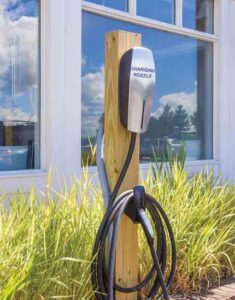The looming 2025 federal Corporate Average Fuel Economy (CAFE) goal of 54.5 miles per gallon across an automaker’s fleet is one of the driving factors behind a series of advancements in more-efficient engine and powertrain technologies. CAFE standards have regulated vehicles’ fuel economy since 1975, with substantial advancements ordered by both the G.W. Bush and Obama administrations. To meet the increasing fuel standards, automakers have relied on a range of vehicle types.
Most people tend to think of hybrids and electric vehicles when talk turns to energy efficient cars. But gasoline-powered cars and trucks are becoming much more efficient with every new generation of vehicles. Direct Injection is one technology that has made many of these vehicles more efficient by shooting gasoline directly into their combustion chambers under high pressure. This precise injection process enables the release of more energy during combustion, limiting wasted fuel.
A transition to smaller, more efficient engines, which can produce the same power as larger engines and provide better overall average fuel economy, is also underway. Called “engine downsizing,” this technique is quite effective and often uses induction air-pressure-boosting devices, such as turbochargers and superchargers, to increase engine performance. Ford has been successful with this approach, making four-cylinder engines perform like six cylinders, and six-cylinder engines deliver the power of a V8.
In just a few short decades, hybrid technology has gone from something reserved for highly specialized cars to a mechanization that’s integrated into popular cars and sport utility vehicles. In a nutshell, a hybrid uses both electric drive and an internal combustion engine to propel the vehicle. When the driver slows, the battery partially recharges through regenerative braking. Today, there are hybrid versions of many modern mid-size sedans and SUVs. The mid-size sedans are now offering Environmental Protection Agency fuel economy numbers in the mid- to upper-40-mpg range. If you know a few fuel-efficiency driving tricks, you can achieve 50-plus mpg. The most recent advancement comes in the form of plug-in hybrids with larger (and more expensive) battery packs that can be charged at home or the office, allowing you to drive the car greater distances on electric power, which significantly improves overall average fuel economy on most trips.
Electric cars are also evolving, but still confront hurdles when it comes to battery cost and a somewhat limited range in certain models. Promising electrics are on the horizon, but it’s best to reserve judgment until we see whether they deliver at a price point more consumers can afford. Hydrogen fuel cell vehicles are also advancing. Essentially, these are electric cars with the electricity supplied by hydrogen and oxygen passing through a fuel cell stack. They’re super-clean, producing only water vapor and a little heat at the tailpipe. Until we have a much larger hydrogen-fuel infrastructure, these types of vehicles will be limited to regional use in major metro areas.
As you can tell, many factors are at play in the greening of the automotive fleet. It’s not all engine technology: Advancements have been made in many other areas, including high-tech transmissions and aerodynamics, which takes weight out of cars and light trucks to improve performance and fuel economy. With the technological competition among automakers, energy efficient cars are evolving at an impressive pace, and that’s a good thing for the planet.




